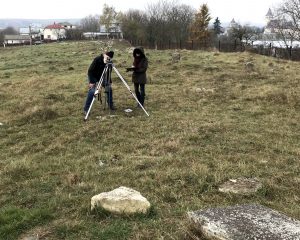![]() Ця сторінка також доступна українською.
Ця сторінка також доступна українською.
This page provides help for first-time visitors to this website in using these resources for best practices guidance and information for Jewish burial site management and care. Included here is a visual and text explanation of the website’s organization and the relationships between its sections, with links to specific webpages by type and category.
First-time Jewish burial site preservation project leaders may also benefit from browsing a separate FAQ page (frequently-asked questions, with answers) for common issues which may arise at the start of a new project.
Organization and Structure of the Website

Learning to deal with new problems in the old Jewish cemetery in Rohatyn
(Ivano-Frankivsk oblast). Photo © RJH.
Jewish cemetery and mass grave projects are complicated, typically with many interlocking elements and dependencies. This website reflects that complexity, and includes over 60 webpages in English (with a parallel number in Ukrainian). The core pages are organized as a matrix, visible both in the menu structure (in the header on every page) and in the table below. The matrix includes three key sections of Guides (best practices), Print and Digital References, and Case Studies (project examples), each represented by a column in the table below. A dozen different but related project categories appear in each of the key sections, and are shown as rows in the table below; the table cells are clickable to navigate the relevant webpage.
For users who prefer a hierarchical listing instead, there is also a separate Sitemap which presents the website as a tree.
| PROJECT CATEGORY | THE GUIDES | REFERENCES | CASE STUDIES |
|---|---|---|---|
| Preliminary Assessment | Guide | ||
| Project Concepts | Guide | References | 17: Rohatyn |
| Site Surveys & Research | Guide | References | 01: Tovste; 02: Tovste; 03: Tovste; 04: Zbarazh |
| Vegetation Clearing/Cleaning | Guide | References | 05: Rohatyn; 06: Bolekhiv |
| Landscape Development | Guide | References | 10: Rohatyn |
| Headstone Recovery & Conservation | Guide | References | 07: Rohatyn; 11: Zaliztsi; 13: Lviv |
| Memorial Monuments | Guide | References | 08: Nadvirna; 14: Zabolotiv |
| Direction & Information Signs | Guide | References | 15: Bolekhiv |
| Fences, Walls, & Gates | Guide | References | 12: Busk |
| Sustainability Planning | Guide | References | 09: Rudky |
| Support & Funding | Guide | References | 17: Rohatyn |
| Communication | Guide | References | 16: Rohatyn |

Using an optical level to measure the locations of objects in the old Jewish cemetery
of Rohatyn. Photo © RJH.
In addition to the main guide, reference, and example sections organized by project categories, there are a few important additional resources on this website which do not easily fit the project category format:
Identified Regional Jewish Burial Sites – A comprehensive listing of the more than 500 identified Jewish cemeteries and mass graves in western Ukraine, organized by oblast and including GPS and map links plus links to the major online databases for further information. Includes an explanatory overview page, and a page plus table each for Lviv oblast, Ivano-Frankivsk oblast, and Ternopil oblast.
Known Regional Preservation Projects – Tabulated lists of Jewish burial sites in western Ukraine with known past, current, or planned preservation projects. A link to project websites is included where available.
Regional and International Experts – A linked listing of known resources for project expertise and advice, both academic and professional, and both organizations and individuals.
Technical Section – As a supplement and extension to the guide pages, these heavily-illustrated pages describe a variety of project-related tools, methods, and data to support burial site preservation projects. Current published pages include:
Tools for Surveying Cemetery Boundaries, Terrain, and Feature Locations
Tools for Trimming, Clearing, and Maintaining Vegetation
Tools for Recovering and Moving Displaced Headstones
Tools for Landscape and Memorial Design
Data: Physical Properties of Stone
As background information to the best practices guides, resources, and case studies, an About the Project page describes the origins and motivations for the research project which created this website, and we acknowledge with gratitude the many Project Contributors who provided research advice, data, and other resources to support the work. Other support and reference pages include the website’s Privacy Policy, plus a Sitemap, a FAQ page, and this How-To page.
